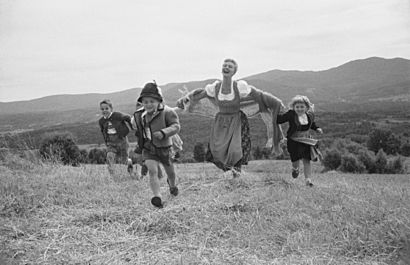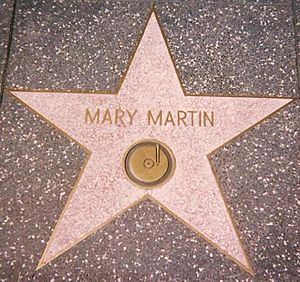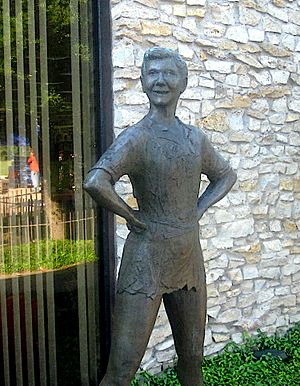Mary Martin facts for kids
Quick facts for kids
Mary Martin
|
|
|---|---|

Martin in 1940
|
|
| Born |
Mary Virginia Martin
December 1, 1913 Weatherford, Texas, U.S.
|
| Died | November 3, 1990 (aged 76) |
| Resting place | Greenwood Cemetery, Weatherford, Texas |
| Occupation | Actress, singer |
| Years active | 1938–1985 |
| Spouse(s) |
Benjamin Jackson "Ben" Hagman
(m. 1930; div. 1936)Richard Halliday
(m. 1940; |
| Children | 2 including Larry Hagman |
| Awards | Outstanding Lead Actress in a Miniseries 1955 Peter Pan Best Leading Actress in a Musical 1950 South Pacific 1955 Peter Pan 1960 The Sound of Music 1989 Kennedy Center Honors |
Mary Virginia Martin (December 1, 1913 – November 3, 1990) was an American actress, singer, and Broadway star. A muse of Rodgers and Hammerstein, she originated many leading roles over her career including Nellie Forbush in South Pacific (1949), Peter Pan in Peter Pan and Maria von Trapp in The Sound of Music (1959). She was named a Kennedy Center Honoree in 1989. She was the mother of actor Larry Hagman.
Contents
Early life
Martin was born in Weatherford, Texas. Her life as a child, as she describes it in her autobiography My Heart Belongs, was secure and happy. She had close relationships with both of her parents as well as her siblings. Her autobiography details how the young actress had an instinctive ear for recreating musical sounds.
Martin's father, Preston Martin, was a lawyer, and her mother, Juanita Presley, was a violin teacher. Although the doctors told Juanita that she would risk her life if she attempted to have another baby, she was determined to have a boy. Instead, she had Mary, who became quite a tomboy.
Martin's family had a barn and orchard that kept her entertained. She played with her elder sister Geraldine (whom she called "Sister"), climbing trees and riding ponies. Martin adored her father. "He was tall, good-looking, silver-haired, with the kindest brown eyes. Mother was the disciplinarian, but it was Daddy who could turn me into an angel with just one look." (p. 19) Martin, who said "I’d never understand the law" (p. 19), began singing outside the courtroom where her father worked every Saturday night at a bandstand. She sang in a trio with her sister and Marion Swofford, dressed in bellhop uniforms. "Even in those days without microphones, my high piping voice carried all over the square. I have always thought that I inherited my carrying voice from my father." (p. 19)
She remembered having a photographic memory as a child. School tests were not a problem, and learning songs was easy. She got her first taste of singing solo at a fire hall, where she soaked up the crowd's appreciation. "Sometimes I think that I cheated my own family and my closest friends by giving to audiences so much of the love I might have kept for them. But that's the way I was made; I truly don't think I could help it." (p. 20) Martin's craft was developed by seeing movies and becoming a mimic. She would win prizes for looking, acting and dancing like Ruby Keeler and singing exactly like Bing Crosby. "Never, never, never can I say I had a frustrating childhood. It was all joy. Mother used to say she never had seen such a happy child—that I awakened each morning with a smile. I don't remember that, but I do remember that I never wanted to go to bed, to go to sleep, for fear I'd miss something." (p. 20)
Marriage
During high school, Martin dated Benjamin Hagman before she left to attend finishing school at Ward–Belmont in Nashville, Tennessee. In Nashville she enjoyed imitating Fanny Brice at singing gigs, but she found school dull and felt confined by its strict rules. She was homesick for Weatherford, her family and Hagman. During a visit, Mary and Benjamin persuaded Mary's mother to allow them to marry. They did, and by the age of 17, Martin was legally married, pregnant with her first child (Larry Hagman) and forced to leave Ward–Belmont. She was, however, happy to begin her new life, but she soon learned that this life as she would later say was nothing but "role playing" (p. 39).
Their honeymoon was at her parents' house, and Martin's dream of life with a family and a white-picket fence faded. "I was 17, a married woman without real responsibilities, miserable about my mixed-up emotions, afraid there was something awfully wrong with me because I didn't enjoy being a wife. Worst of all, I didn't have enough to do." (p. 39) It was "Sister" who came to her rescue, suggesting that she should teach dance. "Sister" taught Martin her first real dance—the waltz clog. Martin perfectly imitated her first dance move, and she opened a dance studio. Here, she created her own moves, imitated the famous dancers she watched in the movies and taught "Sister's" waltz clog. As she later recalled, "I was doing something I wanted to do—creating." (p. 44)
Apprenticeship
Wanting to learn more moves, Martin went to California to attend the dance school at the Franchon and Marco School of the Theatre and then opened her own dance studio in Mineral Wells, Texas. She was given a ballroom studio with the premise that she would sing in the lobby every Saturday. There, she learned how to sing into a microphone and how to phrase blues songs. One day at work, she accidentally walked into the wrong room where auditions were being held. They asked her in what key she would like to sing "So Red Rose". Having absolutely no idea what her key was, she sang regardless and got the job.
Returning to California, Martin was hired to sing "So Red Rose" at the Fox Theater in San Francisco followed by a gig at the Paramount Theater in Los Angeles. There was one catch: she had to sing in the wings. She scored her first professional gig unaware that she would soon be center stage.
Soon after, Martin learned that her studio in Texas had been burnt down by a man who thought that dancing was a sin. She began to express her unhappiness. Her father gave her advice saying that she was too young to be married. Martin left everything behind including her young son, Larry, and stayed in Los Angeles while her father handled her divorce from Benjamin Hagman for her. In Los Angeles, Martin plunged herself into auditions—so many that she became known as "Audition Mary". Her first professional audition and job was on a national radio network. Among Martin's first auditions, she sang, "Indian Love Call". After she finished the song, "a tall, craggly man who looked like a mountain" told Martin that he thought she had something special. It was Oscar Hammerstein II (pp. 58–59). This marked the start of her career.
Radio
Martin began her radio career in 1939 as the vocalist on a short-lived revival of The Tuesday Night Party on CBS. In 1940, she was a singer on NBC's Good News of 1940, which was renamed Maxwell House Coffee Time during that year. In 1942, she joined the cast of Kraft Music Hall on NBC, replacing Connie Boswell. She was also one of the stars of Stage Door Canteen on CBS, 1942–1945.
Broadway

Martin was cast in Cole Porter's Leave It to Me!, making her Broadway debut in November 1938 in that production. She became popular on Broadway and received attention in the national media singing "My Heart Belongs to Daddy". With that one song in the second act, she became a star 'overnight'. Martin reprised the song in Night and Day, a Hollywood film about Cole Porter, in which she played herself auditioning for Porter (Cary Grant). "My Heart Belongs to Daddy" catapulted her career and became very special to Martin—she even sang it to her ailing father in his hospital bed while he was in a coma. Martin did not learn immediately that her father had died. Headlines read "Daddy Girl Sings About Daddy as Daddy Dies". Because of the show's demanding schedule, Martin was unable to attend her father's funeral. In 1943 she starred in the new Kurt Weill musical One Touch of Venus and then Lute Song in 1946.
As nurse Nellie Forbush, Martin opened on Broadway in South Pacific (musical) on April 7, 1949. Her performance was called "memorable ... funny and poignant in turns", and she earned a Tony Award. Richard Watts Jr. of the New York Post wrote: "nothing I have ever seen her do prepared me for the loveliness, humor, gift for joyous characterization, and sheer lovableness of her portrayal of Nellie Forbush .... Hers is a completely irresistible performance." She opened in the West End production on November 1, 1951.
Her next major success was in the role of Peter in the Broadway production of Peter Pan in October 1954 with Martin winning the Tony Award. Martin opened on Broadway in The Sound of Music as Maria on November 16, 1959, and stayed in the show until October 1961. She won the Tony Award for Best Actress in a Musical. The musical gave Martin "the chance to display her homespun charm". In 1966, she appeared on Broadway in the two-person musical I Do! I Do! with Robert Preston and was nominated for the Tony Award (Leading Actress in a Musical). A national tour with Preston began in March 1968 but was cancelled early due to Martin's illness.

Although she appeared in nine films between 1938 and 1943, she was generally passed over for the filmed version of the musical plays. She herself once explained that she did not enjoy making films because she did not have the connection with an audience that she had in live performances. The closest that she ever came to preserving her stage performances was her television appearances as Peter Pan. The Broadway production from 1954 was subsequently performed on NBC television in RCA's compatible color in 1955, 1956, and 1960. Martin also preserved her 1957 stage performance as Annie Oakley in Annie Get Your Gun when NBC television broadcast the production live that year.
While Martin did not enjoy making films, she apparently did enjoy appearing on television as she did frequently. Her last feature film appearance was a cameo as herself in MGM's Main Street to Broadway in 1953. Martin made an appearance in 1980 in a Royal Variety Performance in London performing "Honeybun" from South Pacific. Martin appeared in the play Legends with Carol Channing in a one-year US national tour opening in Dallas on January 9, 1986.
Awards and honors

Martin was inducted into the American Theater Hall of Fame in 1973. She received the Kennedy Center Honors, an annual honor for career achievements, in 1989. She received the Donaldson Award in 1943 for One Touch of Venus. A special Tony was presented to her in 1948 while she appeared in the national touring company of Annie Get Your Gun for "spreading theatre to the rest of the country while the originals perform in New York." In 1955 and 1956, she received, first, a Tony Award for Peter Pan, and then an Emmy for appearing in the same role on television. She also received Tonys for South Pacific and in 1959 for The Sound of Music.
Personal life
After Martin's divorce from Benjamin Hagman, she married Richard Halliday in 1940. Early in their marriage, he worked as a drama critic for the New York World-Telegram and a movie critic for the New York Daily News. Eventually, Halliday became producer or co-producer of at least two of Martin's projects. In the early 1970s, the couple lived, according to his March 1973 obituary in the Connecticut Sunday Herald, "on a vast ranch they own near Anápolis" in the state of Goiás, Brazil. The ranch was called "Nossa Fazenda Halliday" (our Halliday Farm).
Martin was called Dona Maria by neighbors in the vicinity of the Brazilian ranch.
Cultural scholar Lillian Faderman wrote that Martin and actress Janet Gaynor often traveled together along with Halliday and with Gaynor's husband.
On the evening of September 5, 1982, Martin, Janet Gaynor, Gaynor's husband Paul Gregory, and Martin's manager Ben Washer were involved in a serious car accident in San Francisco. Martin sustained two broken ribs and a broken pelvis.
Martin was a Democrat and supported Adlai Stevenson during the 1952 presidential election.
Death
Martin died of cancer four weeks before her 77th birthday at her home in Rancho Mirage, California, on November 3, 1990. She is buried in City Greenwood Cemetery in Weatherford, Texas.
Work
Stage
- Leave It to Me! (1938)
- Nice Goin'! (1939)
- One Touch of Venus (1943–1945)
- Pacific 1860 (1946)
- Lute Song (1946)
- Annie Get Your Gun (1947)
- South Pacific (1949–1951)
- Kind Sir (1953)
- Peter Pan (1954)
- The Skin of Our Teeth (1955)
- Annie Get Your Gun (1957) 10 Weeks Los Angeles and San Francisco
- South Pacific (1957) 10 Weeks touring Los Angeles and San Francisco
- Music with Mary Martin (1958)
- The Sound of Music (1959)
- Jennie (1963)
- Hello, Dolly! (1965–1966) US Tour, Asia and for 6 months in London
- I Do! I Do! (1966–1969) One year on Broadway, nearly one year on tour
- A Celebration of Richard Rodgers (1972)
- Together on Broadway: Mary Martin & Ethel Merman (1977)
- Do You Turn Somersaults? (1978)
- Our Heart Belongs To Mary (1983); 1 performance only at the Shubert Theater on Broadway
- Legends (1985–1987)
Film
Television
|
Radio appearances
| Year | Program | Episode/source |
|---|---|---|
| 1943 | Stage Door Canteen | Curtain Up for Victory |
| 1943 | Philip Morris Playhouse | Roberta |
See also
 In Spanish: Mary Martin para niños
In Spanish: Mary Martin para niños


